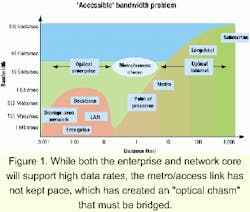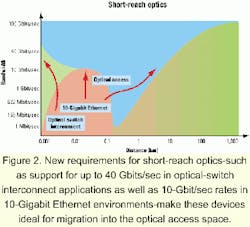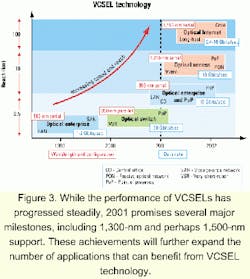Bridging the chasm between the optical enterprise and Internet
VCSEL-based transceivers enable optical bandwidth to the access edge.
WARNER ANDREWS, Picolight Inc.
Transceivers based on vertical-cavity surface-emitting lasers (VCSELs) are the dominant laser communication technology in the optical enterprise for storage-area networks (SANs) and LAN backbones. With the appearance of 10-Gbit/sec VCSEL-based transceivers, VCSEL array transceivers, and 1,310-nm operation, this technology is rapidly migrating "upward" into ultra-high-bandwidth enterprise switching and SAN applications, "inward" into backplanes of large optical switches, and "outward" into optical metro and access applications. It is in the last of these applications-metro and access markets-where VCSEL-based interconnects have a particularly potent opportunity: bridging the gap between an ever-faster optical enterprise and the high-speed optical Internet.
Today, we face a critical bandwidth deficiency in the "access" network-that part of the network comprising the final few kilometers leading to businesses and residences. In the optical enterprise, 100-Mbit/sec desktops are common, as are Gigabit Ethernet fiber backbones and gigabit Fibre Channel SAN interconnects. However, it is not yet possible to extend the high-bandwidth connection out of the optical enterprise to the optical Internet. To reach beyond today's Gigabit Ethernet enterprise environment to the Internet, people are forced to drop down to a several-megabit DSL or T1/E1 rates.
In short, there has emerged an optical chasm between the short-distance optical enterprise network and optical Internet environment. This year, as 10-Gigabit Ethernet begins to appear in the enterprise backbone, the stark gap in speed between enterprise backbones and the access network will become even more apparent. Filling this gap is a great opportunity.
One solution to the optical chasm of Figure 1 is the extension of optical fiber through the access network, or last mile. That not only requires a critical mass of deployed fiber, but also the readiness of service providers and the availability of affordable and easily managed multiplexing equipment. It is in optical-port-intensive multiplexers and concentrators where economical, efficient, and high-performance VCSEL-based interconnects are being prominently featured. Current needs for access infrastructure development include:
- Customer-premises access equipment in buildings or at SONET add/drop multiplexers (ADMs) to take in feeds down to the T1 level or from private branch exchanges (PBXs) and LANs serving an entire building or campus environment.
- Metro/point-of-presence (PoP) equipment to replace SONET ADMs, or to be located at a service provider's central office or metro PoP to aggregate a wide range of Gigabit Ethernet, T1, and other services.
- Optical edge products, which will need to reside in the central office or PoP and act as the bond between a carrier's long-haul DWDM network and its metro DWDM (or SONET) access network.
At several locations around the world, enterprise-derived, bandwidth- and protocol-independent, high-port-density optical access platforms are now designed to exploit the compact size, pluggability, low power dissipation, and dense packaging available with VCSEL transceiver technology. New gigabit-data-rate VCSEL-based transceivers consume less than 300 mW and require just a fraction of a square inch of board space. The benefit to access system providers and their customers is in size, cost-effectiveness, and the flexibility to handle not only single-wavelength point-to-point transmission, but also multiple protocols, shared passive-optical-network interfaces, and in the near future coarse WDM or multiple protocols on separate wavelengths.
The vehicle to deliver that is high-volume, high-performance, and high-efficiency 1,310-nm optical interconnect technology derived from the 850-nm enterprise VCSEL-based transceivers. Are there alternatives? For the access network, probably none derived from the current generation of DWDM. It is not economically feasible to extend the 1,550-nm long-reach optics used in the optical-network core. This ITU-grid technology is two orders of magnitude more costly than VCSEL optics and optimized for distances greater than 100 km rather than the 10-km range of access networks. For the same reasons that optical access system architects are looking to enterprise systems, VCSEL transceiver technology- by virtue of is compact size, reliability, low power, and volume manufacturability-is generally expected to dominate in edge/access switches.The match between 1,310-nm VCSEL technology and the emerging infrastructure needs of the metro and access space has been widely recognized. In the past few years, systems architects and technology planners have begun writing 1,310-nm VCSEL-compatible interface specifications into standards such as 10-Gigabit Ethernet and are debating codification of this technology into "Ethernet in the First Mile." In addition, reach-extensions of existing Gigabit Ethernet LAN and Fibre Channel SAN specifications targeted mostly for campus fiber have been reexamined recently and in some cases incorporated as access specifications.
For access networks, 1,310-nm VCSEL transceivers at the 1- to 2.5-Gbit/sec data rate are used to achieve the necessary reach of up to 10 km, the "sweet spot" of this market. However, 1,310-nm VCSELs are capable-and will certainly appear in-applications serving 10 Gbits/sec and reach distances extending to 40 km.
The approach most leading technologists' support for the development of these devices is to "stand on the shoulders of proven 850-nm VCSEL technology." Materials, packaging, and fabrication approaches that have been proven in the high-volume short-reach VCSEL transceivers are key to developing the volume access market, which dwarfs the network core in terms of unit shipments.
Who will play in this new access-oriented transceiver market? It is very likely that those who can leverage technology in the existing VCSEL-based enterprise transceiver space will dominate.
Packaging, low power dissipation, and pluggability promise to pace the initial inroads 1,310-nm VCSELs will make into the access market. Later, ease of volume manufacturability will be crucial. VCSEL technology at 1,310-nm wavelengths is poised to handle the significantly higher manufacturing volumes required for access market applications. With as many as 250 million desktops and homes worldwide targeted for the gigabit bandwidth necessary to access the Internet for broadband entertainment and information applications, volume 1,310-nm VCSEL manufacturing reliability will be critical.Fortunately, significant improvements in VCSEL alignment capabilities have been achieved over the past several years via process advances and new alignment algorithms. Precision computer-controlled motion stages and sophisticated alignment algorithms ensure maximum coupling efficiency, and these algorithms are now being built right into the firmware on manufacturing-equipment controller boards to reduce intra-instrument communication latency and drive down the cycle time for the alignment process.
Long-wavelength 1,310-nm transceivers are expected to use much the same packaging technology as 850-nm solutions. The most important access transceiver packaging approach will be hot-pluggable, compact transceiver configurations such as those used in the enterprise and SAN space to enable optical service provisioning on demand. Pluggable transceivers allow customers and service providers to purchase a 32- or 64-socket concentrator or switch, then populate ports as needed without bringing down the network. This concept has revolutionized the way enterprise LANs and SANs are designed and deployed and will have a similar impact on access equipment design as this market evolves.
The horizon in access fiber interfaces points toward higher-bandwidth transmission. The new generation of 1,310-nm VCSEL transceivers promises to be capable of supporting multiple wavelengths-far enough apart (4, 10, or 16 wavelengths, fairly widely spread) to maintain direct modulation-and therefore cost-effectiveness. This futureproof feature can allow an order-of-magnitude increase in optical bandwidth across access or metro fiber, without the severe cost penalty imposed by DWDM architectures. As a result of these and other developments, 1,310-nm VCSEL transceivers will play a key role in supporting the emerging "Ethernet in the First Mile" initiative.
Warner Andrews is vice president of marketing at Picolight Inc. (Boulder, CO). He can be reached via the company's Website, www.picolight.com.



